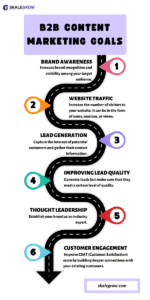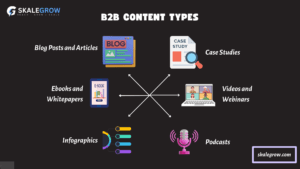B2B content marketing is the act of creating, promoting, and analyzing content that adds value to your ideal prospects. It’s about informing, educating, and ultimately convincing potential clients that your business has the right solution for their needs.
Unlike short-term marketing tactics like ads, content marketing focuses on creating long-term value. Content marketing for B2B is about building trust, credibility, and authority in your industry by offering content that addresses the pain points and challenges of your target audience. By delivering valuable content consistently, businesses can establish themselves as go-to resources in their respective fields.
Role of B2B content marketing in marketing strategy
Content marketing cuts across multiple areas within marketing. It serves as the foundational block that builds and supports various other marketing efforts and channels such as social media, email marketing, search engine marketing, and lead nurturing campaigns.
Here’s how B2B content marketing fits into the bigger picture:
- Brand Awareness: Content marketing is an effective tool for increasing brand visibility and awareness within your industry. By consistently publishing high-quality content, you can expand your reach, capture the attention of potential customers, and improve your brand’s perception.
- Lead Generation: By creating compelling content that resonates with your target audience, you can attract potential leads and nurture them through a series of campaigns. Whether it’s informative blog posts, in-depth whitepapers, or easily consumable videos, high-quality content can act as the biggest lead generation weapon for your B2B business.
- Customer Engagement and Retention: Content can be used as an effective tool for customer engagement and retention. By implementing the right customer marketing efforts, you can use content to engage with your existing customers, increasing your chances of retention. This also helps to increase the LTV (Life Time Value) of your customers over time.
- Thought Leadership: B2B content marketing allows businesses to showcase their expertise and thought leadership within their niche. By sharing industry insights, best practices, data-backed predictions, and innovative ideas, businesses can establish themselves as leaders in their field and differentiate themselves from competitors. Talking about the latest trends is also a great way to exhibit thought leadership using content.
- Search Engine Optimization (SEO): Content is core to optimizing your website for search engines. While SEO focuses on choosing the right keywords to optimize your website for, it is content that converts these keywords into well-written blog posts and landing pages. Content also helps SEO by improving the average dwell time on web pages.
Developing your B2B Content Marketing Strategy
Here, let us look at the step-by-step process of crafting a winning B2B content marketing strategy.
Identify your Target Audience and their needs
Identifying your target audience is the first step to a well-planned B2B content marketing strategy. Knowing who you are writing content for helps to come up with the right topic ideas, follow a specific tone, address your audience’s pain points, etc. Following are the steps involved in this process:
- Understanding your Audience: Ask yourself these questions – Who is your target audience? What are their pain points, challenges, and goals?
- Creating Buyer Personas: Develop detailed profiles for each of your ideal customer groups so that you can plan your content creation efforts accordingly.
- Conducting Market Research: Use surveys, interviews, and data analysis to gain insights into your audience’s preferences and behaviors.
- Mapping the Buyer’s Journey: Identify the stages of the buyer journey by mapping out different stages of the content marketing funnel. This way, you can plan what type of content to create for each stage.
Perform a Content Gap Analysis
A content gap analysis allows you to understand what is already out there so that you can create a piece that is completely on a new topic or shares a different perspective on something already discussed.
Focus on the following steps while performing a content gap analysis:
- Competitor Analysis: Analyze the content produced by your competitors and popular bloggers in your space to identify gaps and opportunities. Use tools like Ahrefs and BuzzSumo to do this.
- Industry Trends and Insights: Stay up-to-date with the latest trends, news, and developments in your industry to get trending topic ideas. You can use tools like Google Trends and SparkToro for this.
- Content Audit: Evaluate your existing content assets to identify strengths, weaknesses, and areas for improvement.
Here is the list of content marketing tools every B2B marketer should know: 70+ B2B Content Marketing Tools
Define your Content Goals
Whether it’s generating leads, increasing brand awareness, or establishing thought leadership, defining clear goals will guide your content strategy and help you measure success effectively.
Given below are some examples of B2B content marketing goals:

- Brand Awareness: Increase brand recognition and visibility among your target audience.
- Website Traffic: Increase the number of visitors to your website. It can be in the form of users, sessions, or views.
- Lead Generation: Capture the interest of potential customers and gather their contact information.
- Improving lead quality: Generate leads but make sure that they meet a certain level of quality.
- Thought Leadership: Establish your brand as an industry expert and someone who leads the way when it comes to adopting new techniques and methodologies.
- Customer Engagement: Improve CSAT (Customer Satisfaction) score by building deeper connections with your existing customers.
To set clear content goals, you need to build a B2B content marketing funnel specific to your business model. This helps to clearly visualize the needs and pain points of your prospects by understanding their stage in the buying journey.
As you do this, ensure that your content goals align with the overall marketing strategy and the broader business objectives. Determine which goals are most important, prioritize them, and allocate resources accordingly.
Also read: How to manage multiple content distribution goals
Topic Research
Topic research is a key stage in the overall process of B2B content marketing. This is where you carefully choose your topics such that they are relevant from an SEO as well as a business standpoint. Do the following for conducting a comprehensive topic research:
- Keyword Research: Identify relevant keywords and search terms related to your industry, products, and services (check out this article to learn how to do keyword research and topic ideation).
- Content Ideation: Brainstorm topics and ideas based on keyword research, industry trends, customer feedback, and common questions or pain points. You can also take the help of tools like Ahrefs, SEMRush, Google Trends, or SparkToro.
- Content Validation: Validate potential topics by assessing their relevance, search volume, competition, and potential impact on your target audience.
- Content Planning: Planning your content creation process well in advance helps you to allocate resources the right way and ensure that you are able to churn out content as fast as you can.
Content Creation
With your topics identified, it’s time to roll up your sleeves and get creative. Whether you’re writing blog posts, designing infographics, or producing videos, the key is to create content that’s not only informative but also engaging and compelling.
Below are a few best practices you can follow when it comes to content creation:
- Writing Engaging Copy: Craft compelling headlines, introductions, and body copy that captivate your audience’s attention and encourage them to keep reading. Also consider SEO (optimize the title, H1, description, etc.) while you create the content item if it is indexed.
- Visual Content Creation: Create attention-grabbing visuals, such as infographics, videos, and images, to complement your written content and enhance engagement.
- Editing and Optimization: Review and refine your content for clarity, accuracy, and relevance, and optimize it for search engines and social media platforms. If time permits, come back and review your content a second time the next day. This allows the brain to avoid any biases and look at the content with a fresh eye.
- Content Collaboration: Collaborate with subject matter experts, influencers, and other stakeholders to enhance the quality and credibility of your content. You can also explore lean influencer marketing methods in case you are tight on budget.
With this content creation process in mind, let’s look at a few examples of B2B content types that tend to perform the best.

- Blog Posts and Articles: Blog posts and articles are long-form content items that allow you to cover a particular topic in detail. You can create how-to guides, write practical tips, and educate your audience on industry trends and updates.
- Ebooks and Whitepapers: Ebooks and whitepapers dive deep into specific topics, providing in-depth analysis, and reports. They’re well suited for showcasing your industry expertise and establishing yourself as a thought leader in the niche.
- Infographics: Want to create compelling visuals of your message? Infographics make complex information easy to digest, perfect for grabbing and retaining your audience’s attention.
- Case Studies: Case studies are customer success stories where you have delivered a great amount of value. They help improve trust and credibility, and encourage prospects even more to explore your solutions.
- Videos and Webinars: Whether it’s a product demo, a thought leadership interview, or a live Q&A session, video content brings a personal touch to your brand and helps you connect with your audience on a deeper level.
- Podcasts: Podcasts are gaining traction in B2B and are seen as one of the most trusted sources of knowledge. There is far less competition in podcasting compared to other channels and podcasts can help you earn a competitive advantage if you start one today.
Creating a Content Calendar and Editorial Plan
Consistency is key in content marketing, and a well-planned editorial calendar can help you stay on track. By mapping out your content schedule in advance and aligning it with your overall business objectives, you can ensure that your content strategy remains focused and effective.
Perform the following steps to plan your B2B content marketing activities:
- Establishing a Content Schedule: Determine the frequency of publishing content and create a content calendar based on that.
- Content Themes and Topics: Based on the research you conducted, plan out the themes, topics, and key messages you’ll cover in your content.
- Assigning Responsibilities: Make sure every content piece has an owner and delegate tasks and responsibilities to relevant team members.
- Review and Approval Processes: Establish workflows and protocols for reviewing, approving, and scheduling content before it goes live. Be sure to have the right checks and balances in place in order to ensure that the content is of high quality.
Publishing and promoting your content through various channels
Content distribution is as important as (if not more important than) content creation. A content piece unseen is the same as one uncreated. So, you need to make sure that you promote your content and that it reaches your target audience.
Focus on the following to achieve this:
- Content Distribution Strategy: Identify the channels and platforms where your target audience is most active so that you can distribute content where they want and when they want.
- Social Media Promotion: Share your content across your social media channels, using compelling visuals, hashtags, and calls to action to maximize engagement.
- Email Marketing Campaigns: Incorporate your content into email newsletters, drip campaigns, and automated workflows to drive traffic and leads.
- Influencer Outreach: Collaborate with influencers, industry experts, and brand advocates to amplify your content reach and credibility (remember the lean influencer marketing ideas we discussed earlier).
To learn a structured framework for content distribution, check out the below article:
Content Distribution 101 – How To Find The Perfect Mix Of Marketing Channels
Measuring and analyzing content performance
Measuring the impact of your content marketing helps to optimize your content for better performance in the future. It also helps with revenue attribution by determining which content pieces are contributing the most to the topline of the business.
There are two types of metrics you need to measure:
- Leading indicators: These are top-of-the-funnel metrics that tell you whether you are able to generate enough demand using content.
- Conversion metrics: These focus on whether the leads you generate using content travel further down the marketing and sales funnel.
To learn in detail about these metrics and how to measure them, read the below article:
Content Marketing Analytics – What It Is And How To Build A System For It
And finally, know these common mistakes in B2B content marketing to avoid: 7 Mistakes To Avoid in B2B Content Marketing
Conclusion
Creating a successful content marketing strategy for a B2B business requires dedication and planning, but the benefits are well worth the effort. Remember, B2B marketing is all about building relationships and establishing trust. So, the key is to focus on providing genuine value to your target audience. By consistently creating informative and engaging content, you will be able to attract leads, establish thought leadership, and ultimately achieve your B2B marketing goals.
Skalegrow – B2B content marketing agency
With marketing getting tougher and tougher, every wrong foot you make might hamper your growth. What you need is the right guidance and a helping hand. This is where Skalegrow can make a sea of difference.
Skalegrow helps IT, tech, SaaS, robotics, and embedded systems companies leverage new-age marketing tactics to grow their business. From creating an end-to-end content distribution strategy to building a customer-focused content repository, we can help you with everything content. Write to us today at info@skalegrow.com or contact us here to learn how we can generate more demand for your solutions using content.
Check out the below intro video to learn more about what Skalegrow brings to the table:


